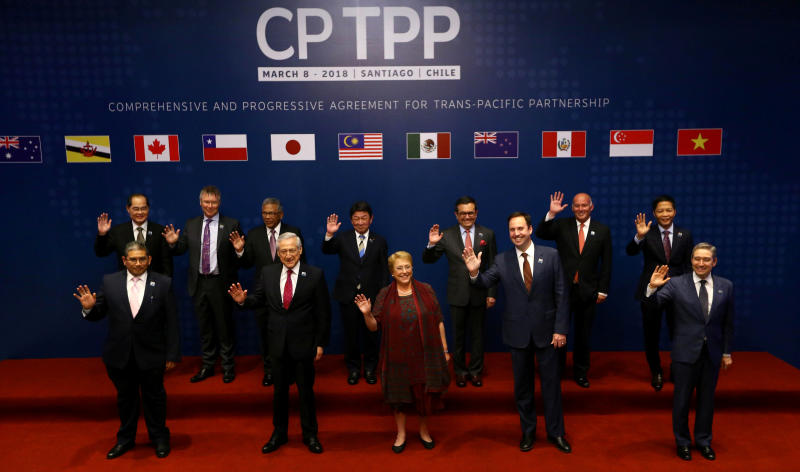How easy would it be for US to rejoin TPP?
Sign up now: Get insights on Asia's fast-moving developments

Representatives of members of Trans-Pacific Partnership (TPP) trade deal pose for a picture before the signing agreement ceremony in Santiago, Chile on March 8, 2018.
PHOTO: REUTERS
Follow topic:
SINGAPORE/WELLINGTON (REUTERS) - US President Donald Trump said last week he would reconsider joining the landmark Trans-Pacific Partnership (TPP) trade agreement if it were a "substantially better" deal than the one offered to President Barack Obama.
Here is a look at the state of play in the negotiations and the conditions needed to be in place for the United States to join an agreement Mr Trump scrapped as soon as he took office.
1. WHAT ARE THE TPP AND CPTPP?
The original 12-member agreement was known as the TPP. It was a signature trade policy of Mr Obama, but he was unable to secure Congressional support for the deal.
It was thrown into limbo when Mr Trump withdrew from the deal three days after his inauguration in January 2017, a move he said was aimed at protecting US jobs.
Following the US withdrawal, the remaining 11 countries renegotiated parts of the TPP, removing some of Washington's demands.
In March, they signed the Comprehensive and Progressive Agreement for Trans-Pacific Partnership (CPTPP), also known as TPP-11.
The trade deal becomes effective when ratified by six of the signatories. It will reduce tariffs in countries that together amount to more than 13 per cent of the global economy - a total of US$10 trillion (S$13.12 trillion) in gross domestic product.
With the United States, it would have represented 40 per cent.
The members of the CPTTP are Australia, Brunei, Canada, Chile, Japan, Malaysia, Mexico, New Zealand, Peru, Singapore, and Vietnam.
2. WHAT HAS TRUMP SAID RECENTLY ON TPP?
- Republican senators met Mr Trump on April 12 and he told them that he has asked United States Trade Representative Robert Lighthizer and White House economic adviser Larry Kudlow to re-open negotiations.
- Mr Trump on Twitter, April 12: "Would only join TPP if the deal were substantially better than the deal offered to Pres. Obama. We already have bilateral deals with six of the eleven nations in TPP, and are working to make a deal with the biggest of those nations, Japan, who has hit us hard on trade for years!"
- Mr Trump in a CNBC interview, Jan 25: "I would do TPP if we made a much better deal than we had. We had a horrible deal."
3. HOW WOULD THE US REJOIN THE TRADE PACT?
It would not simply be a case of reopening the original TPP deal, given the remaining 11 changed it and Mr Trump has said he would seek a better deal.
"It's very, very unlikely that you're just going to have negotiation on the existing text and have the US say, 'Oh, we want those suspended articles re-instated and we'll just sign,'"said Mr Charles Finny, a Wellington-based trade consultant and a former New Zealand government trade negotiator.
"It's probably going to be quite a long negotiation and it's probably going to be called something else and it's probably going to look quite different from TPP."
The CPTPP is expected to be ratified early next year, which is the earliest the United States could formally start negotiations to join.
All 11 nations must agree to admit a new member, giving each of them a veto.
4. A BETTER DEAL?
The 11 countries suspended about 20 provisions in the original deal.
Many of them were pushed by Washington, including terms that strengthened intellectual property (IP) protection for certain pharmaceutical products, extended the length of copyrights and reduced barriers for express shipments companies.
The TPP-11 legal text is 584 pages, versus the 622 pages original which included the United States.
Eighteen of the pages dropped were in the IP chapter, which Washington saw as very important and was one of the hardest to negotiate.
A possible US return to the deal would also require reopening negotiations on some sore points for existing members including Japan, such as tariffs for pick-up trucks and quotas for how much of auto manufacturing has to be done within the signing countries.
Japan wants to keep sourcing auto parts from economies not in the pact, such as Thailand.
Aside from this, Washington might want to push for further concessions on agricultural products, which are mainly produced in states that Mr Trump won in the 2016 election.
Rice, which Japan sees as a national security staple, might be one of the toughest items on the negotiation list.
Technically, reinstating the suspended provisions would not be difficult. "Improving" on them is another matter.
"They are suspended on purpose. They (TPP-11 countries) could have cancelled them, but they chose not to do so," said Ms Deborah Elms, Founder and Executive Director of Singapore-based Asian Trade Centre and a senior fellow in the Singapore Ministry of Trade and Industry's Trade Academy.
"The tricky part is that the United States, especially under this administration, anything that the Obama administration touched, they want re-done... I do not think that there is appetite among the eleven, at least at this point, for complicated renegotiations."

